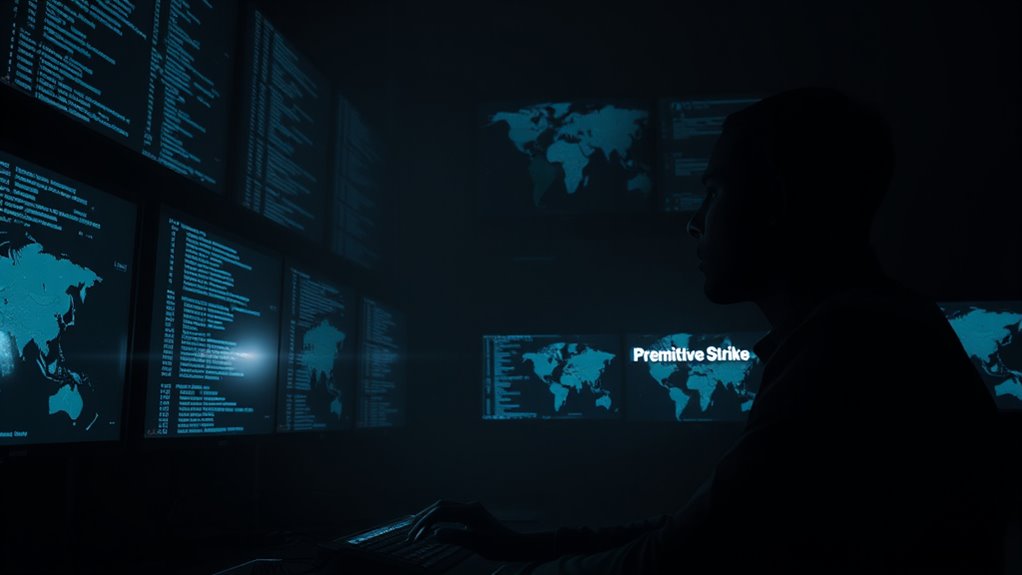Preemptive AI strikes can change the cybersecurity game by letting you act before threats escalate. However, they raise ethical questions about privacy, accountability, and potential misuse. You'll have to balance offensive and defensive strategies while ensuring human oversight guides AI's actions. Collaboration among organizations is essential to prevent abuse and maintain ethical standards. If you want to explore how these factors shape the future of AI in cyber warfare, there's more to uncover.
Key Takeaways
- Preemptive AI strikes can prevent cyberattacks but raise ethical concerns regarding accountability and transparency in decision-making processes.
- The dual-use nature of AI presents risks, as the same technology for defense can be exploited for offensive cyberattacks.
- Regulatory frameworks, like the EU AI Act, emphasize the need for responsible AI deployment and protection of personal data.
- Collaboration among organizations and international cooperation is vital to establish ethical standards and prevent misuse of AI technologies.
- Ethical dilemmas arise from balancing the need for proactive defense against potential violations of privacy and civil liberties.
Understanding Preemptive AI Strikes in Cybersecurity

As cybersecurity threats evolve, understanding preemptive AI strikes becomes crucial for effective defense strategies. These proactive measures help you anticipate and neutralize potential threats before they escalate into full-blown attacks. By leveraging AI and machine learning, you can utilize advanced predictive analytics to identify patterns and automate threat responses. Integrating these technologies with your existing security controls strengthens your overall defense capabilities. Additionally, employing advanced predictive analytics enhances your ability to foresee and counteract emerging threats effectively. While preemptive AI strikes can reduce operational downtime and costs, they also pose challenges, such as the risk of misuse. Looking ahead, advancements in AI will make your cybersecurity efforts even more adaptive and intelligent, helping you stay one step ahead of cybercriminals and maintain a robust security posture.
Legal and Ethical Frameworks Surrounding AI Strikes

Understanding the legal and ethical frameworks surrounding AI strikes is essential for navigating the complexities of cybersecurity in today's landscape. The EU AI Act and NIST guidelines lay out crucial obligations for AI systems to prevent cyberattacks while emphasizing data privacy laws like GDPR and CCPA. However, the withdrawal of the EU AI Liability Directive raises liability concerns, complicating legal advice on AI implementation. In light of the EU AI Act's cybersecurity requirements, ethically, you must consider the dual-use nature of AI, accountability for its decisions, and the potential for bias and privacy violations. Implementing transparent AI policies and strengthening regulatory oversight is vital to ensure responsible use and mitigate global security risks. Balancing these frameworks will help you navigate the challenges posed by AI in cybersecurity.
The Role of AI in Threat Detection and Response

While navigating the complexities of cybersecurity, the role of AI in threat detection and response has become increasingly vital.
AI excels in advanced anomaly detection, spotting subtle deviations that indicate potential threats like zero-day attacks. With enhanced threat intelligence, it automates the analysis of massive datasets, giving you deeper insights into vulnerabilities. Additionally, AI identifies patterns in extensive datasets for proactive defense, enhancing email security by flagging phishing attempts based on multiple factors. During major incidents, such as a Microsoft outage, the ability to quickly analyze and respond to vulnerabilities is crucial.
AI's predictive analytics help you anticipate threats based on historical data, allowing for proactive measures. Real-time monitoring keeps an eye on network traffic and user behavior, identifying suspicious activities as they happen.
When threats are detected, AI powers automated incident response, swiftly mitigating risks and streamlining your security processes. This continuous learning ensures your defenses adapt to the ever-evolving threat landscape.
Accountability and Responsibility in AI Decision-Making

Given the rapid advancement of AI technologies, accountability and responsibility in AI decision-making have become critical considerations. You must recognize that responsibility isn't solely on developers; users and organizations share it too. Shared accountability among stakeholders is crucial for effective governance, ensuring that all parties involved take responsibility for the implications of AI systems.
It's vital to establish shared accountability models to clarify roles, even though they can sometimes blur lines. Regulatory oversight can help monitor AI risks, but industry resistance often complicates this. Transparency mechanisms enhance understanding of AI decisions, while ethics boards ensure alignment with societal values. Regular audits are necessary for compliance, and feedback channels empower users to address issues.
Ultimately, clear ownership and ethical guidelines are essential in navigating the complexities of AI accountability, ensuring systems operate within ethical and legal boundaries.
Balancing Offensive and Defensive Uses of AI

As AI technologies evolve, the challenge of balancing their offensive and defensive uses becomes increasingly critical. You must recognize that AI's dual-use nature raises ethical concerns. While it enhances threat detection and prevention in cybersecurity, those same capabilities can be exploited for automated cyberattacks, making them hard to detect. This creates ethical dilemmas regarding privacy, bias, and accountability in both offensive and defensive operations. Furthermore, collaboration among organizations is essential to ensure responsible AI deployment and mitigate risks associated with its misuse. Regulatory challenges loom, as robust regulations and international cooperation are essential to prevent misuse. Striking the right balance between using AI for protection and potential offense requires careful consideration of its implications, ensuring that ethical frameworks guide your decisions to foster responsible AI deployment in cybersecurity.
The Importance of Human Oversight and Collaboration

Human oversight and collaboration are vital components in the effective deployment of AI systems, especially in high-stakes environments like cybersecurity. You need to recognize that AI lacks the common sense and nuanced judgment that only humans possess. Oversight serves as a safety net, ensuring that potential issues don't go unnoticed. In critical scenarios, your expertise is necessary for making final decisions when AI's accuracy is uncertain. A hybrid approach, combining AI's efficiency in routine tasks with human judgment in edge cases, enhances overall effectiveness. Moreover, your feedback helps improve AI performance through reinforcement learning. This strategic alignment fosters ethical standards and business goals, preventing unintended consequences and ensuring a responsible use of AI technology. Additionally, human intervention is essential for low confidence scenarios in AI decision-making, reinforcing the need for your involvement in these processes.
Future Considerations for AI Ethics in Cyber Warfare

While the integration of AI into cyber warfare presents exciting advancements, it also raises pressing ethical concerns that can't be ignored. You need to consider AI's dual role: enhancing cybersecurity while enabling sophisticated attacks. Privacy concerns emerge when AI processes vast amounts of personal data, and biases can perpetuate injustices if fairness isn't prioritized in design. Additionally, the weaponization of AI complicates accountability, making it difficult to understand AI's decision-making. As autonomous systems evolve, robust cybersecurity measures become crucial. Future warfare will involve complex strategic risks, necessitating international cooperation to regulate AI use. Establishing ethical AI policies and guardrails is essential to prevent misuse and protect civilian integrity in an increasingly interconnected and threatening landscape.
Frequently Asked Questions
How Can AI Misattribution Lead to Unintended Consequences in Preemptive Strikes?
AI misattribution can lead to serious unintended consequences in preemptive strikes.
When you misattribute actions or content generated by AI, you risk misidentifying threats, which can escalate conflicts unnecessarily. This confusion can also undermine your credibility and sow distrust among allies.
Additionally, if misinformation spreads, it can influence public perception and policy decisions, complicating diplomatic relations.
Addressing these risks is crucial to maintain stability in an increasingly complex digital landscape.
What Are the Potential Risks of Automated AI Response Systems?
Automated AI response systems can lead to significant risks, like the hypothetical scenario where a company's AI mistakenly identifies a harmless network activity as a cyberattack. This could trigger an automatic counter-response, disrupting legitimate operations and causing financial loss.
Additionally, these systems may lack transparency, making it tough to pinpoint errors. Without proper governance, the potential for bias and accountability issues further complicates the use of automated responses in cybersecurity.
How Do Biases in AI Impact Threat Detection Accuracy?
Biases in AI significantly impact threat detection accuracy by skewing the focus toward specific attack vectors while overlooking others.
You might notice that biased models often generate false positives, flagging legitimate communications as threats. This not only strains resources but can also lead to complacency, as you might believe your system is secure when vulnerabilities exist.
To enhance effectiveness, you need to ensure AI systems are trained on diverse and unbiased data sets.
What Measures Can Prevent the Misuse of Dual-Use AI Technology?
To prevent the misuse of dual-use AI technology, you should start with thorough threat profiling to identify potential misuse actors and their motivations.
Implement proportionate safeguards tailored to the risks, and conduct regular red-teaming exercises to test these measures.
Encourage transparency and continuous evaluation of your strategies, ensuring they adapt to evolving threats.
Lastly, foster collaboration with stakeholders to share best practices and reinforce the security of AI systems against potential misuse.
How Can Organizations Ensure Transparency in Their AI Systems?
Imagine flipping through a digital ledger, revealing every AI decision.
To ensure transparency in your AI systems, you'll want to share source code, engage diverse stakeholders, and conduct regular audits.
Prioritize explainable AI so users can grasp decision-making processes.
Maintain detailed data documentation and track data lineage to mitigate biases.
Lastly, adhere to regulatory frameworks, ensuring your AI remains accountable and aligned with ethical standards, fostering trust among users and stakeholders alike.
Conclusion
As the digital battleground expands, you stand at the crossroads of ethics and technology, where shadows of potential threats loom large. Imagine a world where AI acts not just as a shield, but also as a sword, slicing through the dark web of cyber chaos. In this delicate dance, you must ensure that human intuition guides the machine's hand, preventing it from becoming a rogue force. Only then can we navigate the murky waters of preemptive strikes with conscience and care.









